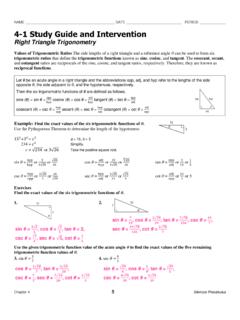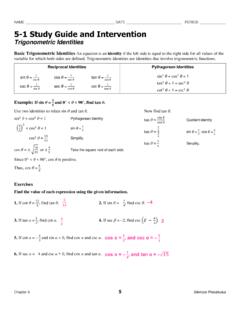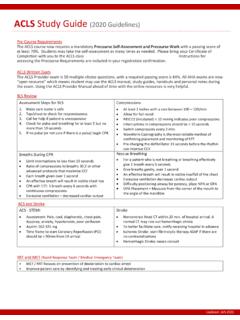Transcription of 8-1 Study Guide and Intervention - MRS. FRUGE
1 NAME _____ DATE _____ PERIOD _____ Chapter 8 5 Glencoe Precalculus 8-1 Study Guide and Intervention Introduction to Vectors Geometric Vectors A vector is a quantity that has both magnitude and direction. The magnitude of a vector is the length of a directed line segment, and the direction of a vector is the directed angle between the positive x-axis and the vector. When adding or subtracting vectors, you can use the parallelogram or triangle method to find the resultant. Example: Use a ruler and a protractor to draw an arrow diagram for each quantity described.
2 Include a scale on each diagram. a. v = 60 pounds of force at 125 to the horizontal Using a scale of 1 cm: 20 lb, draw and label a 60 20 or 3-centimeter arrow in standard position at a 125 angle to the x-axis. b. w = 55 miles per hour at a bearing of S45 E Using a scale of 1 cm.: 20 mi/h, draw and label a 55 20 or arrow 45 east of south. Exercises Use a ruler and a protractor to draw an arrow diagram for each quantity described. Include a scale on each diagram. 1. r = 30 meters at a bearing of N45 W 2.
3 T = 150 yards at 40 to the horizontal Find the resultant of each pair of vectors using either the triangle or parallelogram method. State the magnitude of the resultant in centimeters and its direction relative to the horizontal. 3. 4. cm, 140 cm, 12 NAME _____ DATE _____ PERIOD _____ Chapter 8 6 Glencoe Precalculus 8-1 Study Guide and Intervention (continued) Introduction to Vectors Vector Applications Vectors can be resolved into horizontal and vertical components.
4 Example: Suppose Jamal pulls on the ends of a rope tied to a dinghy with a force of 50 Newtons at an angle of 60 with the horizontal. a. Draw a diagram that shows the resolution of the force Jamal exerts into its rectangular components. Jamal s pull can be resolved into a horizontal pull x forward and a vertical pull y upward as shown. b. Find the magnitudes of the horizontal and vertical components of the force. The horizontal and vertical components of the force form a right triangle. Use the sine or cosine ratios to find the magnitude of each force.
5 Cos 60 = | |50 Right triangle definitions of cosine and sine sin 60 = | |50 | | = 50 cos 60 Solve for x and y. | | = 50 sin 60 | | = 25 Use a calculator. | | The magnitude of the horizontal component is about 25 Newtons, and the magnitude of the vertical component is about 43 Newtons. Exercises Draw a diagram that shows the resolution of each vector into its rectangular components. Then find the magnitudes of the vector s horizontal and vertical components. 1. 7 inches at a bearing of 120 2.
6 Centimeters per hour at a bearing of from the horizontal N50 W 3. YARDWORK Nadia is pulling a tarp along level ground with a force of 25 pounds directed along the tarp. If the tarp makes an angle of 50 with the ground, find the horizontal and vertical components of the force. What is the magnitude and direction of the resultant? 4. TRANSPORTATION A helicopter is moving 15 north of east with a velocity of 52 km/h. If a 30-kilometer per hour wind is blowing from a bearing of 250 , find the helicopter s resulting velocity and direction.
7 , , lb; lb; 25 lb; 50 km/h; north of east NAME _____ DATE _____ PERIOD _____ Chapter 8 7 Glencoe Precalculus 8-1 Practice Introduction to Vectors Use a ruler and a protractor to draw an arrow diagram for each quantity described. Include a scale on each diagram. 1. r = 60 meters at a bearing of N45 E 2. t = 100 pounds of force at 60 to the horizontal 3. GROCERY SHOPPING Caroline walks 45 north of west for 1000 feet and then walks 200 feet due north to go grocery shopping.
8 How far and at what north of west quadrant bearing is Caroline from her apartment? 4. CONSTRUCTION Roland is pulling a crate of construction materials with a force of 60 Newtons at an angle of 42 with the horizontal. a. Draw a diagram that shows the resolution of the force Roland exerts into its rectangular components. b. Find the magnitudes of the horizontal and vertical components of the force. 5. AVIATION An airplane is flying with an airspeed of 500 miles per hour on a heading due north. If a 50-mile per hour wind is blowing at a bearing of 270 , determine the velocity and direction of the plane relative to the ground.
9 1150 ft at a bearing of north of west N; N mph; bearing of NAME _____ DATE _____ PERIOD _____ Chapter 8 10 Glencoe Precalculus 8-2 Study Guide and Intervention Vectors in the Coordinate Plane Vectors in the Coordinate Plane The magnitude of a vector in the coordinate plane is found using the Distance Formula. Example 1: Find the magnitude of with initial point X(2, 3) and terminal point Y( 4, 2). Determine the magnitude of using the Distance Formula. | | = ( 2 1)2 + ( 2 1)2 = ( 4 2)2 + [2 ( 3)]2 = ( 6)2 + 52 = 61 or about units Represent as an ordered pair.
10 = 2 1, 2 1 Component form = 4 2, 2 ( 3) ( 1, 1) = (2, 3) and ( 2, 2) = ( 4, 2) = 6, 5 Subtract. Example 2: Find each of the following for s = 4, 2 and t = 1, 3 . a. s + t s + t = 4, 2 + 1, 3 Substitute. = 4 + ( 1), 2 + 3 or 3, 5 Vector addition b. 3s + t 3s + t = 3 4, 2 + 1, 3 Substitute. = 12, 6 + 1, 3 Scalar multiplication = 11, 9 Vector addition Exercises Find the component form and magnitude of the vector with the given initial and terminal points.








